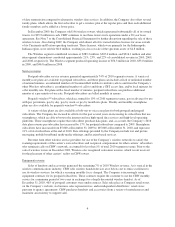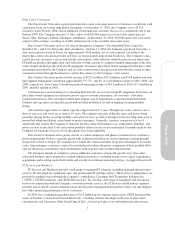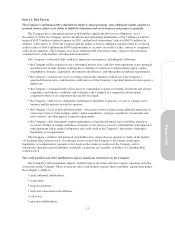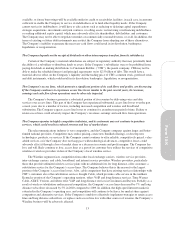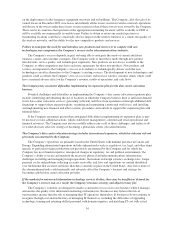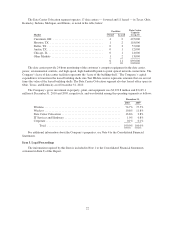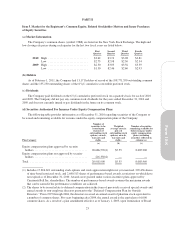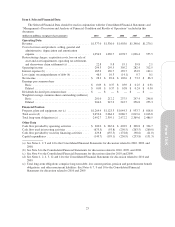Cincinnati Bell 2010 Annual Report Download - page 106
Download and view the complete annual report
Please find page 106 of the 2010 Cincinnati Bell annual report below. You can navigate through the pages in the report by either clicking on the pages listed below, or by using the keyword search tool below to find specific information within the annual report.on the deployment of radio frequency equipment on towers and on buildings. The Company, after the sale of its
owned towers in December 2009, now leases substantially all the towers used in its wireless network operations,
and the use of the towers under these leases is more restrictive than if these towers were owned by the Company.
There can be no assurance that spectrum or the appropriate transmitting locations will be available to CBW or
will be available on commercially favorable terms. Failure to obtain or retain any needed spectrum or
transmitting locations could have a materially adverse impact on the wireless business as a whole, the quality of
the wireless networks, and the ability to offer new competitive products and services.
Failure to anticipate the need for and introduce new products and services or to compete with new
technologies may compromise the Company’s success in the telecommunications industry.
The Company’s success depends, in part, on being able to anticipate the needs of current and future
business, carrier, and consumer customers. The Company seeks to meet these needs through new product
introductions, service quality, and technological superiority. New products are not always available to the
Company, as other competitors may have exclusive agreements for those new products. New products and
services are important to the Company’s success as its industry is technologically driven, such that new
technologies can offer alternatives to the Company’s existing services. The development of new technologies and
products could accelerate the Company’s loss of access lines and increase wireless customer churn, which could
have a material adverse effect on the Company’s revenue, results of operations, and cash flows.
The Company may encounter difficulties implementing its expansion plan for the data center colocation
business.
Potential challenges and difficulties in implementing the Company’s data center colocation expansion plan
include: identifying and obtaining the use of locations in which the Company believes there is sufficient demand
for its data center colocation services; generating sufficient cash flow from operations or through additional debt
financings to support these expansion plans; recruiting and maintaining a motivated work force; and installing
and implementing new financial and other systems, procedures and controls to support this expansion plan with
minimal delays.
If the Company encounters greater than anticipated difficulties in implementing its expansion plan, it may
be necessary to take additional actions, which could divert management’s attention and strain operational and
financial resources. The Company may not successfully address any or all of these challenges, and failure to do
so would adversely affect its strategy of becoming a global data center colocation business.
The Company’s data center colocation strategy includes international expansion, which has inherent risk not
previously encountered by the Company.
The Company’s operations are primarily based in the United States with minimal presence in Canada and
Europe. Expanding international operations includes inherent risks such as: regulatory, tax, legal, and other items
specific to particular foreign jurisdictions not previously encountered by the Company and for which the
Company has no or limited expertise; unexpected changes in regulatory, tax and political environments; the
Company’s ability to secure and maintain the necessary physical and telecommunications infrastructure;
challenges in staffing and managing foreign operations; fluctuations in foreign currency exchange rates; longer
payment cycles and problems collecting accounts receivable; and laws and regulations on content distributed
over the Internet that are more restrictive than those currently in place in the United States. Any one or more of
the aforementioned risks could materially and adversely affect the Company’s business and strategy for
becoming a global data center colocation provider.
If the markets for outsourced information technology services decline, there may be insufficient demand for
the Company’s services and, as a result, the Company’s business strategy and objectives may fail.
The Company’s solutions are designed to enable a customer to focus on its core business while it manages
and ensures the quality of its information technology infrastructure. Businesses may believe the risk of
outsourcing is greater than the risk of managing their IT operations themselves. If businesses do not continue to
recognize the high cost and inefficiency of managing IT themselves, including the difficulties of upgrading
technology, training and retaining skilled personnel with domain expertise, and matching IT cost with actual
16


